“Architecture is a constant struggle,” says Josh de Sousa, 39, partner with his wife, Nancy Hou, 39, in the Manhattan firm Hou de Sousa. Adds Hou: “We like the process of finding the answer that solves all the competing forces in a project. It’s sort of an experiment every time.” This explains why Hou de Sousa enters so many competitions—it won nine in the past three years (mostly for installations in public spaces), including one during the pandemic, a welcome opportunity in a time when many architects have lost work.

AURORA: This proposal for a site in San Jose, CA, is a hybrid bridge and civic space that comes alive through human engagement at a multitude of entrances and intersections. Its gentle arc allows the public to experience nature on a variety of tiers. Image courtesy Hou de Sousa, click to enlarge.
For public spaces, they often come up with schemes that invite visitor participation. “Our goal is that as many people as possible enjoy our projects,” Hou says. “We want to appeal to people who may see a project once or twice but also those who experience it every day.” The couple is full of invention, producing showstopping installations, often in Day-Glo colors. “Early on, our palette was muted, but it’s not subtle now,” de Sousa says. “When we confronted our first project intended for nighttime display, we discovered how well bright colors work.”
They have been attracted to projects in subways, parks, and churches, and like to experiment with recycled and inexpensive materials, including hula hoops, fishnets, discarded lumber, and iridescent parachute cord. “We enjoy finding ways of employing common materials for unorthodox uses,” de Sousa says.
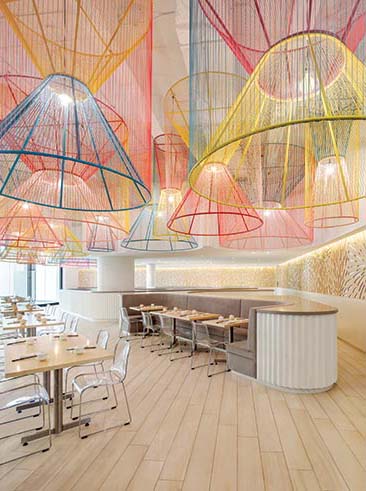
HAPPY PANDA II: The design combines the qualities of American diners and casual Chinese restaurants. The aim was to quickly construct a comfortable and airy dining space that takes full advantage of the double-height space. Photo © Bicubik - Sebastian Crespo and Andrés Fernández
The early years of the firm were spent in Quito, Ecuador, where Hou’s Chinese parents had settled when she was 7 (Hou met the Massachusetts-born de Sousa as an undergraduate). The pair returned there last year, but remotely, to do a third restaurant, Happy Panda II. For its double-height space, they designed giant cone-shaped lanterns using yellow, red, and turquoise paracord tightly strung between circular metal frames. “It was a lot of Zoom calls,” Hou says.
In 2018, for a competition they won for a park in Washington, D.C., they devised a 700-square-foot maze named Prismatic. Iridescent rope was woven between lightweight steel lattices forming nine separate geometric configurations. As the visitors moved among them, they saw an ever-changing kaleidoscope of orange, lime, yellow, and pink lines.
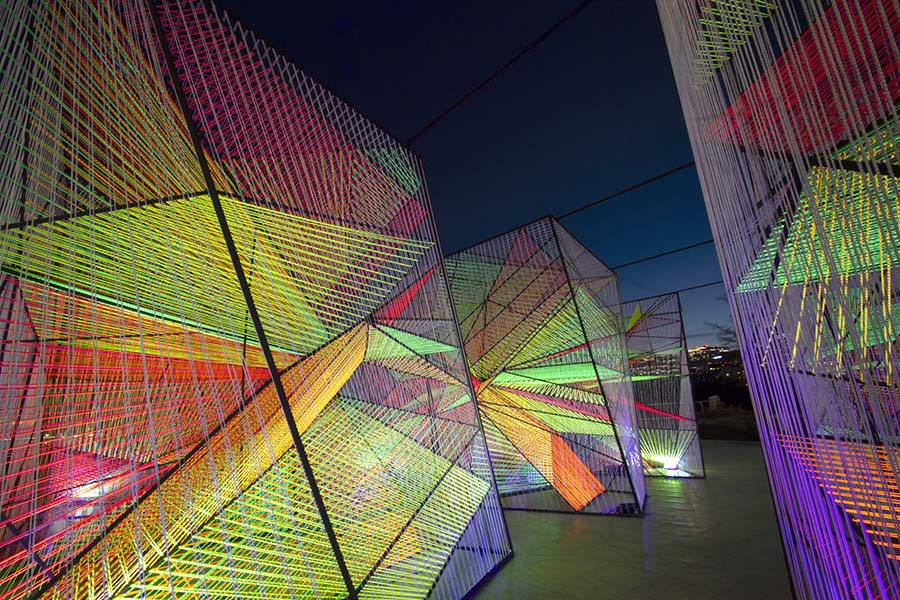
PRISMATIC. Photo © Hou de Sousa

GO: Scheduled to open at the Google headquarters in Mountain View, California, next year, the iglooshaped enclosure features a series of discs that can be manually flipped. Each marble face poses a question, either profound or silly. One example: What shape is the universe? Image courtesy Hou de Sousa
In 2022, they will install Go, the winning entry for a permanent outdoor pavilion at the new Google campus in Mountain View, California. Named after the ancient Chinese board game (and with a nod to “Google”), Go is an 8½-foot-tall ribbed, igloo-shaped enclosure. Round double-sided disks, sandwiches of charred lumber and white marble, are mounted to the ribs like a string of pearls. Each marble face poses a question, either profound or silly (vetted by Google).
The firm has renovated a few apartments and created an art piece for a real-estate firm in Washington, D.C., but Hou likes competitions because “they have many layers of meaning and interpretation.”
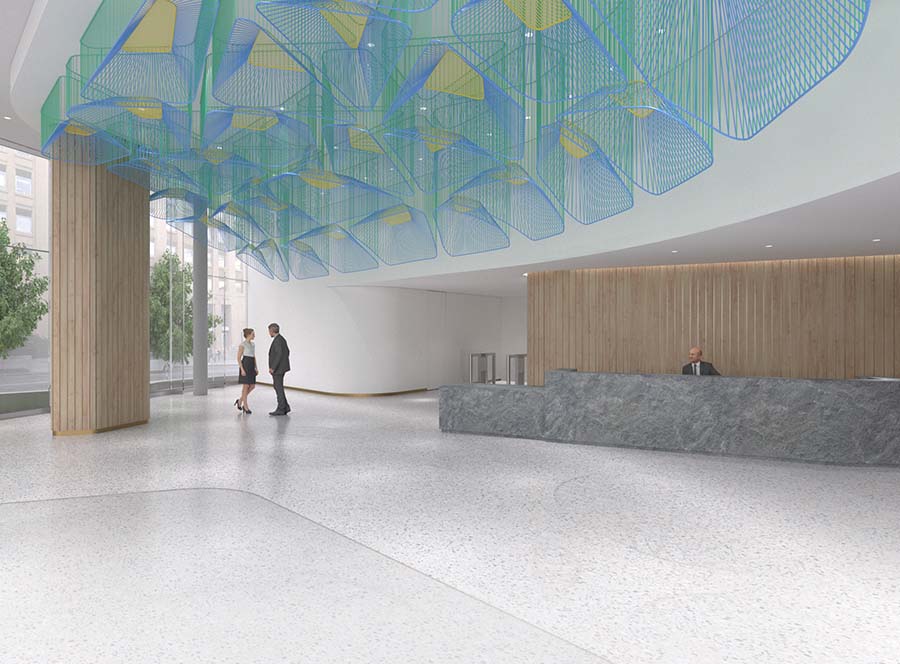
WMATA HQ/Jair Lynch Real Estate Partner Permanent Art Installation: Washington DC. Image courtesy Hou de Sousa
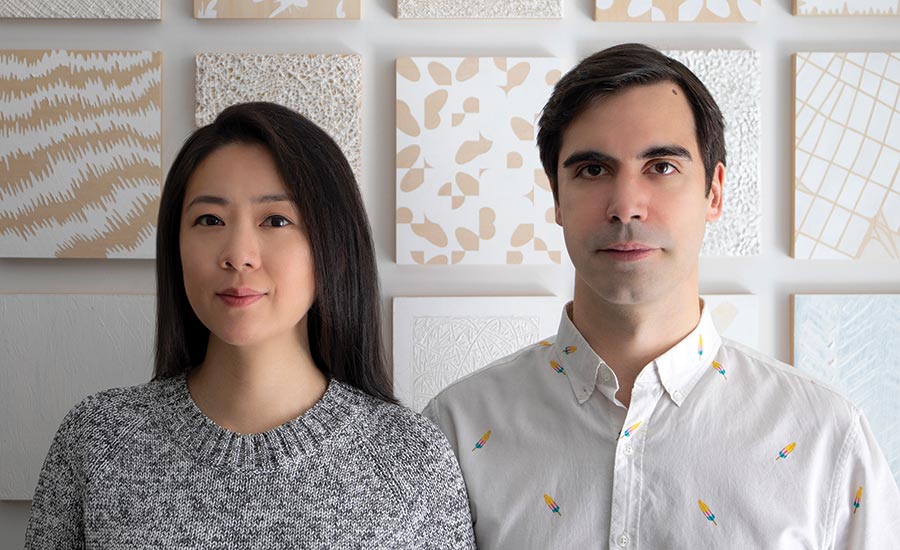
Nancy Hou and Josh de Sousa. Photo © Hou de Sousa
FOUNDED:
2010
DESIGN STAFF:
3–4
PRINCIPALS:
Nancy Hou, Josh de Sousa
EDUCATION:
Hou: Harvard Graduate School of Design, M.Arch., 2008; Cornell University, B.Arch., 2005. De Sousa: Harvard Graduate School of Design,
M.Arch., 2008; Cornell University, B.Arch., 2005
WORK HISTORY:
Hou: Stephanie Goto Design, 2008–10; Slade Architecture, 2005–06; KPF, 2004. De Sousa: Joel Sanders Architect, 2009–10; Polshek Partnership, 2008–09; OMA, 2007; Simone Giostra and Partners, 2005–06; SOM, 2004
KEY COMPLETED PROJECTS:
Happy Panda II, Quito, Ecuador, 2020; Ziggy, New York, 2019; High Line Stations, New York, 2019; Sticks II, New York, 2019; Prismatic, Washington, D.C., 2018; Sticks, New York, 2016; Raise/Raze, Washington, D.C., 2016; Happy Panda, Quito, Ecuador, 2013; Dim Sum Bar, Quito, Ecuador, 2011
KEY CURRENT PROJECTS:
WMATA Triptych, Washington, D.C.; Go, Mountain View, CA; Bubble, Ogden, UT; Poly, Sarasota, FL
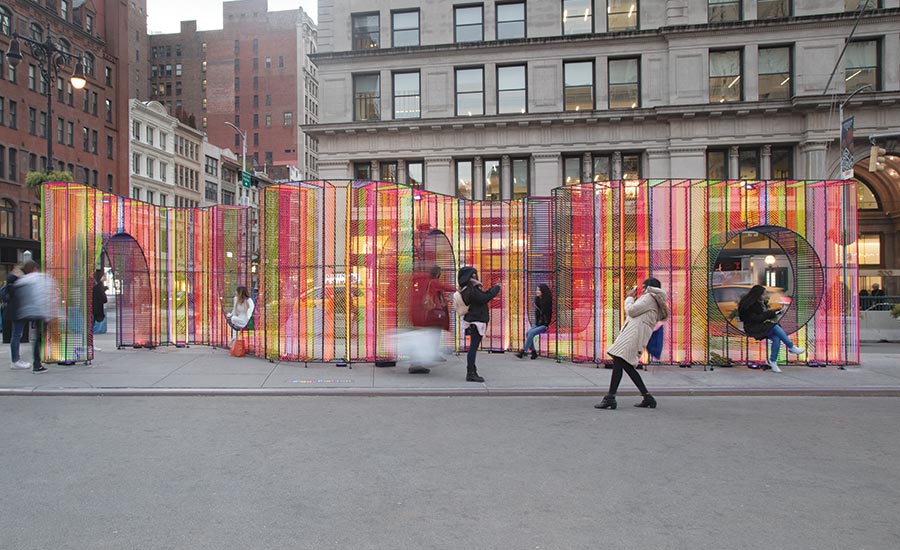

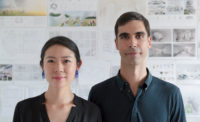
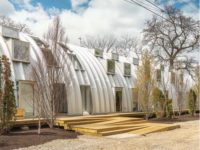
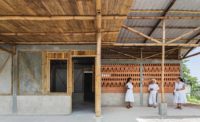
Post a comment to this article
Report Abusive Comment